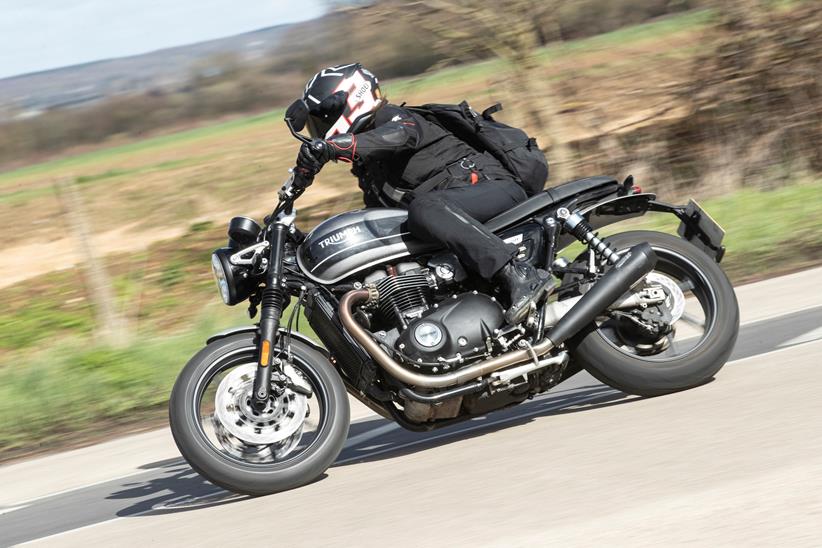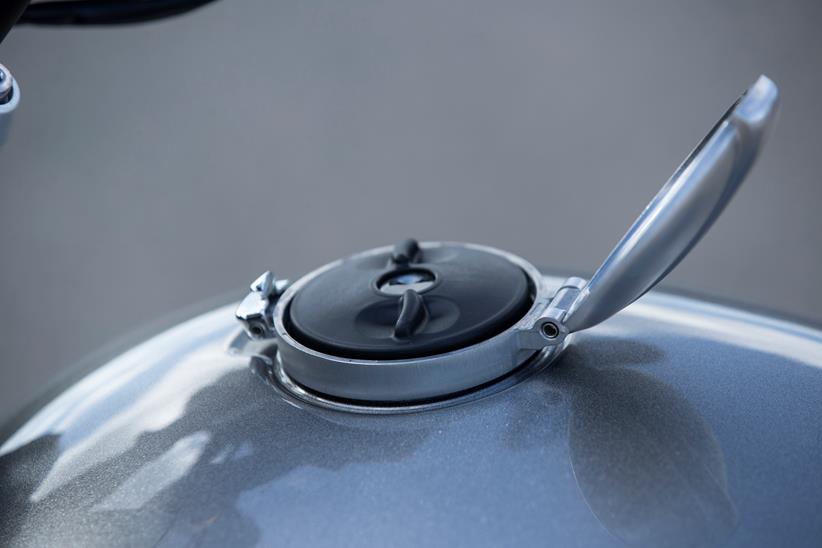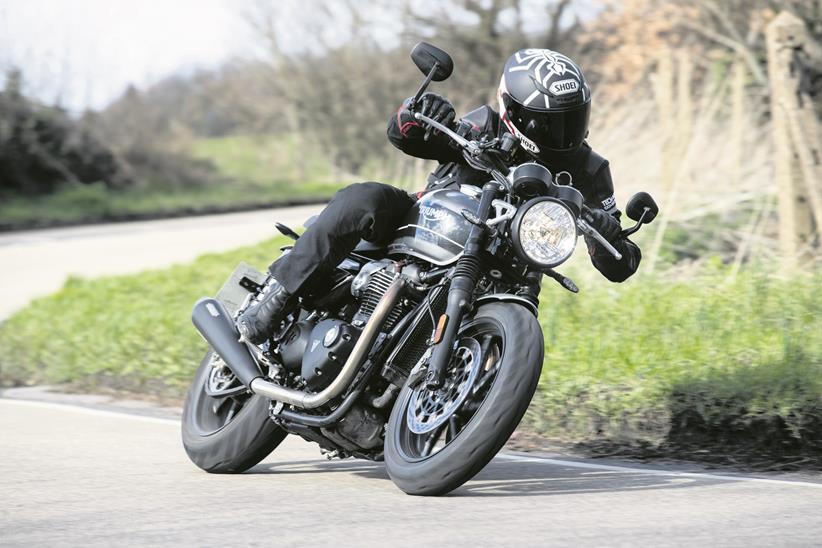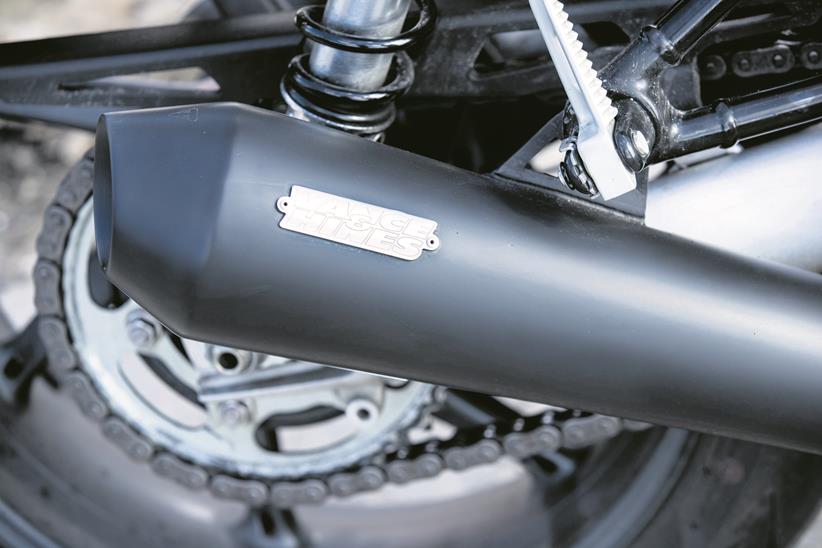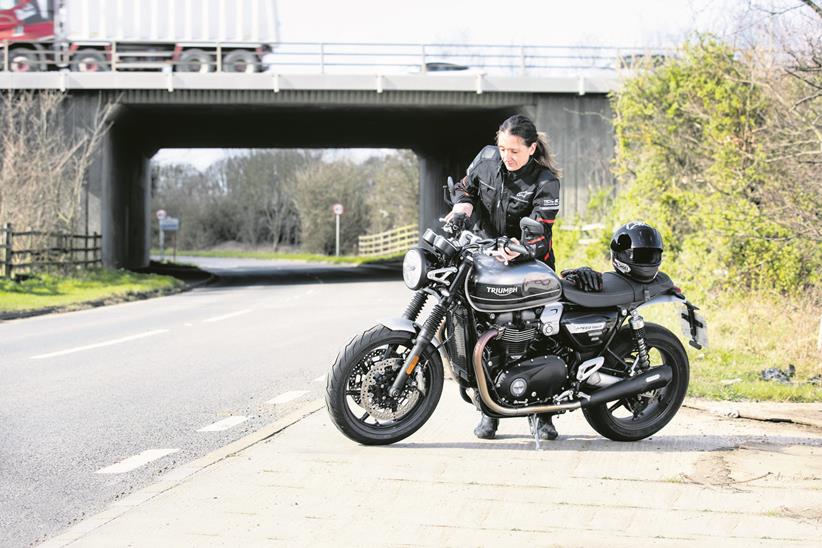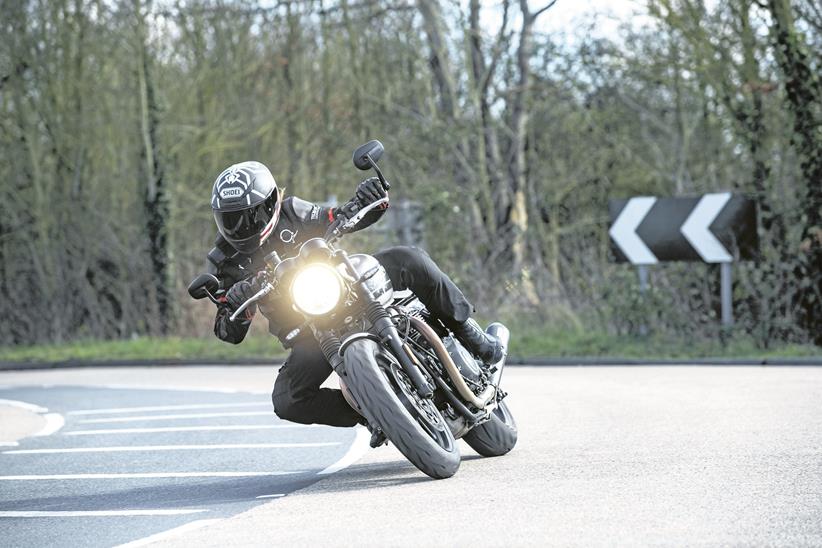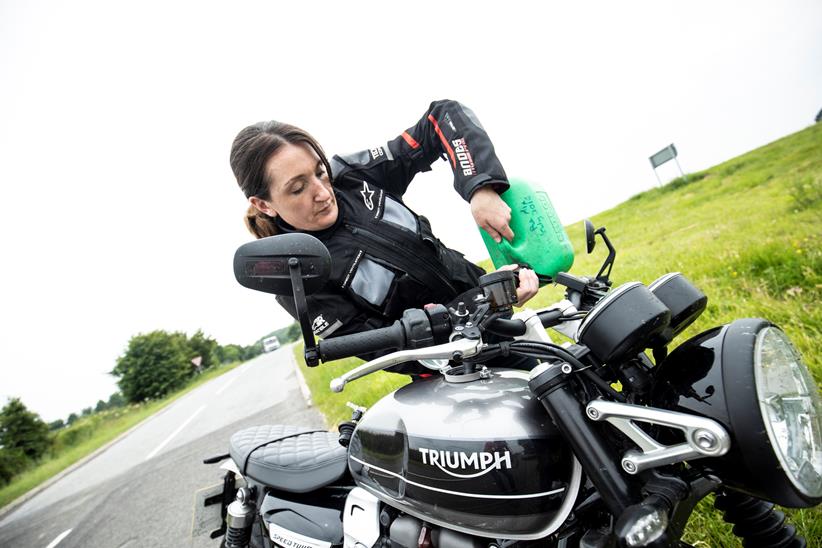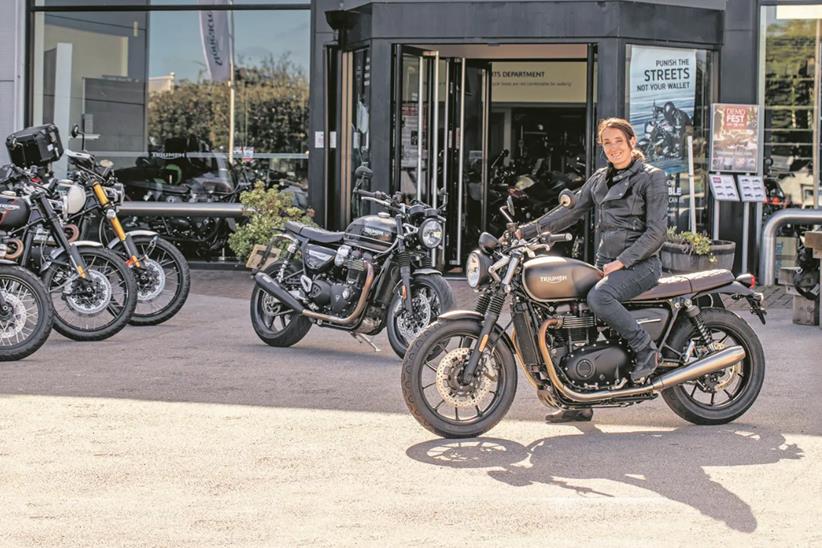MCN Fleet: Torquey Triumph Speed Twin shows mercy on its stock tyres
Looking back on those heady days of Springtime, when the tarmac was warm and the Triumph Speed Twin‘s odometer was only showing triple digits, I distinctly remember wondering about how much abuse the rear tyre was taking.
Sure, the Triumph retro is no big-power sportsbike, but given the fact that the 1200cc Bonneville HT engine produces 82.6ftlbs at just 4950rpm and its communicative lightweight steel/aluminium hybrid frame makes accessing that shove extremely easy, every corner exit on every ride became an exercise in exploiting that torque via whacking great fistfuls of throttle. Yeeha!
Owing to that pummelling, I was fully expecting the stock Pirelli Diablo Rosso III rear to be way past its best by the time I’d clicked through 3500 miles. But six months and over 4000 miles later, the rear rubber’s still clinging on in there and has only just become square enough to be detected on turn-in.
It’s an impressive performance from a tyre that sits on the sportier end of the road rubber market. Given that there’s usually a trade off when it comes to outright grip versus longevity, the Rosso IIIs have remained steadfast to the road surface in all conditions and kept the Speed Twin reassuringly stable.
![]()
Although I initially had my doubts as to whether the factory-fitted Pirellis were the exact same spec an off-the-shelf pair, simply because they didn’t ever give me that truly keyed-in grip feel as you usually get from the brand’s other tyres, given the mileage that they’ve endured I can’t really grumble.
For riding a 96bhp bike on Britain’s sketchy roads, the Rosso III have been excellent – and for those wanting a little more in terms of fast-road performance, the sportier Rosso Corsa II have also been homologated by Triumph for use on their 1200cc retro roadster, but they will set you back around £50 more per pair than the Rosso III and arguably won’t last quite as long.
One observation worth noting is how sensitive that the front tyre appears to be to a slight drop in pressure. The Speed Twin has a slightly muted turn-in which becomes downright ponderous once the front tyre’s pressure drops from the recommended 36psi down to say 34psi, which is all the more reason to keep your tyre pressure gauge close at hand.
Triumph Speed Twin: The story so far
- Update 1: An introduction
- Update 2: Getting to know you
- Update 3: Absolute zero
- Update 4: Comfort
- Update 5: Is bigger better?
Update five: Is bigger better? Emma compares the Triumph Speed Twin against the cheaper Street Twin
Published: 25.09.19
![]()
At first glance, Triumph’s retro roadsters – the Triumph Speed and Triumph Street Twins – look almost identical; the same charmingly circular headlamp, traditional teardrop tank, and clever air-cooled-aping fin-cylindered twin-pot engine.
It’s exactly the same deal as the British brand’s tri-cylinder modern nakeds – the Triumph Speed Triple and Triumph Street Triple – which take a keen eye to tell apart. Yet sling a leg over and the differences are stark, and in the case of the Triples it’s not the bigger bike that’s the better ride, as the cheeky 765-powered Street Triple results in an overall better mix of power, handling, value and fun.
That got me thinking, if Triumph’s Street Triple is better than its big brother then perhaps the 900cc Street Twin will provide a more pleasing package than my 1200cc Speed Twin long termer. With that in mind, I popped along to Triumph World in Chesterfield where Sales Specialist, Dan Hunt, let me try a Street Twin for size.
Weight – Speed Twin wins
Amazingly, during my very first interaction with the smaller bike – simply pushing it backwards out of a parking space – I was amazed by how much heavier it felt. At 198kg, the smaller capacity machine has a claimed weight 2kg heavier than my 1200cc Speed Twin, despite its smaller engine and single-disc front brake. It’s not much, but it is very noticeable.
![]()
Ergonomics and instruments – Draw
Sat astride the Street Twin, it’s strikingly similar to my larger, more premium Speed Twin. The riding position is identical, save for an even more relaxed seat-to-peg ratio courtesy of the 47mm lower seat.
The Speed Twin isn’t a tall bike but the Street Twin will be extremely confidence inspiring for short riders. The single-dial instrument cluster is the most obvious difference from the rider’s seat, but other than not having an analogue tacho it’s got all the same functionality as the Speed’s.
Engine and throttle – Draw
The six-speed 1200cc makes 97bhp and generates 82ft-lbs of torque at 4950rpm, and not just that but the Thruxton-based engine itself feels more refined and lighter than the five-speed 900cc version inside the Street Twin; it revs more freely and feels like it has less inertia on a closed throttle.
But that’s not to say the smaller bike is lacking in grunt; it has a real kick at the low end of the rev range – putting out a decent 60ftlbs of torque at just 3800rpm. The fly-by-wire throttle response feels smoother on the smaller bike too, as its twin-mode system doesn’t feature the snatchy Sport setting of the larger Speed Twin. That said, the larger bike’s motor is much more engaging and will appeal to more performance-minded riders.
Handling – Speed Twin wins
Triumph make bikes that handle wonderfully well, and both models are a real joy to hustle through the bends. You don’t even question the Street’s 18in front wheel with its 100/90 Pirelli Phantom tyre, it steers remarkably sweetly and is genuinely fun to ride.
But when you jump on the Speed Twin with its 17in front wheel, you immediately notice the difference; the steering is wonderfully direct and linear and the whole chassis feels just that little bit plusher.
Value – Street Twin wins
The Street Twin costs from £8100, whereas the Speed Twin is £10,700. Yes, the bigger bike is more powerful and more refined – but is it worth the £2600 extra? I’m not convinced.
For gentle pottering around on B-roads, both bikes take it all in their stride. They’ve got accessible and engaging engines, excellent handling, loads of comfort and great looks. Plus, both boast switchable rider modes and traction control, too.
Unless you specifically want the Speed Twin’s premium package and superior performance capabilities, or spend a lot of time two-up, the Street Twin is definitely worth considering.
Update four: Are you sitting comfortably?
Published: 14.08.19
![]()
The Triumph Speed Twin is quite honestly one of the most comfortable bikes I’ve ever ridden. A combination of the relaxed riding position, ideally-damped suspension and perfectly padded standard seat mean that you can genuinely spend full days in the saddle without so much as a hint of pain.
At least, it was until I decided to fit the quilted bench seat from the official Triumph accessories catalogue. A direct replacement to the standard seat, as soon as I removed the replacement perch from its packaging, I knew I’d be trading a little bit of the aforementioned comfort, despite Triumph’s claims that the internal ‘3D mesh’ would boost it.
Clipped in place, the quilted seat looks absolutely lovely but it only took a short ride before I was shuffling around in discomfort. It’s just a lot thinner and less padded than the stocker meaning that it’s no good for riders who want to ride more than 20 minutes at a time. It simply feels like the whole set-up’s got firmer.
![]()
With nearly 3500 miles on the odometer, the OE Pirelli Rosso III tyres are still holding up pretty well, with no visible signs of squaring off – not that the Speed Twin does that much straight-line motorway bashing.
Despite being something of a Pirelli fan, I’ve not been overly impressed with the Rosso III on the Speed Twin. Whilst there appears to be plenty of grip in wet and dry conditions, there’s not much in the way of feel or feedback so I never get the sensation of being completely hooked up.
It could be that these are lower, OE-spec Rosso IIIs and fitting an off-the-shelf set of Pirellis, or indeed another brand, might give me the feel that I’m missing, but the problem’s not bad enough to warranty me junking a perfectly serviceable pair of tyres. Best get some more miles put on them, then….
Update three: Absolute Zero
Published: 02.07.19
![]()
What does a chocolate fireguard, an inflatable dartboard, and a sunroof on a submarine have in common with the fuel range computer on the Triumph Speed Twin? Answer – they’re all completely useless.
For a few months now, I’ve had my suspicions about the Twin’s fuel range. With a brimmed tank, the LCD fuel gauge takes a few minutes to register the full 14.5 litres; the read-out on the range indicator rising while each segment builds in on the tapered bar gauge.
Once it displays as full, the computer then tells me that I’ve got 130 miles before I’ll be running on empty, which is all well and good, however, I’ve been finding that I’ve only been able to squeeze 11.5 litres into the tank when the range finder is showing just one mile left. Now, either the tank isn’t as big as Triumph claim (14.5 litres) or the trip computer isn’t very good at its job. It was time to find out….
Tank brimmed, I had an appointment to meet an MCN reader for a photoshoot up at Cadwell Park, which is 70 miles of wonderfully fast-but-twisty A-roads away from my front door.
Not in any way riding for economy, a return journey would more than drain the tank if the range computer was to be believed. So I glugged a couple of litres of unleaded into a plastic petrol container, shoved it inside my trusty old Kriega rucksack and set off northeastwards to the lovely Lincolnshire Wolds.
With loads of torque and being so super stable in the bends, the Speed comes alive on fast, open country lanes. I’ve mentioned before that the best and smoothest way to ride it is via shortshifting, but I can’t seem to break the habit of a lifetime spent riding two strokes so end up revving it to 6500rpm in every gear, close to its 7k redline. Like I say, not the most economical yet the computer says mpg is still at 52.5mpg.
On the return leg, the fuel light flickers on at 108 miles and the range informs me that I need to be filling up in 40 miles time; that’s 18 miles more than it estimated when I first filled it up this morning. I’m two miles from the MCN office when the fuel range drops from two miles, to one, then to zero, before just displaying dashes where the number should be.
That’s it, nothing left. The trip was showing I’d actually covered 142 miles before the range reached zero. I start to feel a little vulnerable out on the fast dual carriageway so decide to head to some quieter country lanes where it’d be safer to run dry. It felt weird, but I continued to ride normally.
![]()
Even though I had my suspicions that there was still quite a fair bit left in the tank, knowing you’re just about to run out of fuel is still nerve wracking. How far would I get? I estimated about another 10 miles – that to me sounded like a good bit of redundancy, a bit of a built-in fail safe…
Nope, not 10 miles. Not 20 miles. I was still riding up and down the same country lane after 30 miles on zero range and was starting to wonder whether the Speed Twin was powered by a nuclear reactor. Then, a few miles later – it happened.
Slowing for a downhill crossroads, the Twin stopped. Shaking the tank I managed to fire it up and get another quarter of a mile up the road before it cut out again, but this time it was dry. The trip showed that I’d covered 179.5 miles since I’d filled up that morning – which I’m really impressed with.
Why the range computer is so inaccurate is beyond me, but at least now I know that even when I’m riding hard down country lanes, the Speed Twin will do at least 179 miles to empty and returns 56.44mpg – perhaps even more if I was riding for economy. Here’s to fewer visits to the petrol station this summer!
Update two: Getting to know you
Published: 03.04.19
![]()
“That’s the new Triumph Speed Twin, I’ve got one of them on order…” If I had a quid for every time I’ve heard that in the past couple of weeks I’d be a wealthy woman.
Seems I’m going to be in very good company riding Triumph’s latest retro this summer because it appears the world and his wife have signed up to buy one. And, after my first few weeks with our long-term test Triumph Speed Twin, I can see why they’re proving such a hit.
Firstly, it looks gorgeous. Hinckley’s design brigade have got the retro styling spot on – there’s no pretence, nothing jarring or garish – the Speed is just a really attractive, traditionally styled roadster, backed up with modern conveniences such as three rider modes, traction control and ABS.
Our long-termer features the Silver Ice and Storm Grey colour scheme with hand-painted graphite coach line (£300 extra), and I think it blurs the line between modern and traditional really well.
I especially like the two side airbox covers, and the little details such as the Triumph logos stamped on the plug caps. This one’s also been fitted with Triumph Vance & Hines black ceramic-coated pipes (£695) which look great but are a little underwhelming in the sound department. But soundtrack aside, it’s definitely a bike to be pored over and savoured.
Then there’s the performance. Powered by a reworked version of the high-power 1200cc Bonneville engine from the cafe racer Triumph Thruxton 1200, I’ve discovered the Speed more than lives up to its name out on twisty rural back roads, where it burps out of bends on a torrent of torque – 82ft-lbs to be precise.
Coming from two-strokes and inline four sportsbikes with comparatively astronomic powerbands, it’s taken me a while to recalibrate my riding style to suit the lazier, low-revving Triumph, which demands short-shifting through the six-speed box rather than burying the needle deep into the 7000rpm redline.
![]()
But this switch of gears allows me to get the very best from the Speed’s impressive cornering capabilities. Fast, flowing bends are where it excels most. Roll it in, let it settle onto its line, then blast it out.
Being an impressive 10kg lighter than the Thruxton thanks to pared-down transmission components reducing engine inertia, as well as lightweight wheels, the Speed Twin is absolutely effortless to ride and is in fact so agile and responsive that Triumph actually had to open the wheelbase out a little in order to preserve stability.
So although it shares the same frame as the Thruxton the new naked is actually 15mm longer, at 1430mm. I’m genuinely impressed with the handling so far and it’s definitely my favourite aspect of the bike. Even the non-adjustable KYB suspension is good, remaining composed while accelerating and braking, as well as riding over bumps nicely.
The new Speed Twin gives you National Speed Limit fun without the risk of having your collar felt (well, maybe just a little roadside telling off…) because 80mph is pretty much all you can take before windblast pummels your shoulders and neck, forcing you to slow down. For me, it definitely proves the point that you can enjoy twisty roads without going crackers with speed or taking risks.
Although, it’s not all roses; there are a few minor annoyances which I’ll tell you about next time. Until then, if you’ve got a Speed Twin – or you’re waiting for yours to arrive – please get in touch and tell me how you’re getting on here.
Update one: Introducing the Triumph Speed Twin
Published: 29.03.19
![]()
After years of riding sportsbikes, I fancied switching gears for 2019. That’s not to say that I’ve not had some eclectic long-term test bikes over recent years – with bikes as diverse as KTM’s RC390 and Ducati’s XDiavel being the wildly different bookends. Somewhere between the two is the new Speed Twin.
- Related: Read the full Triumph Speed Twin review
- Related: Triumph Speed Twin – the story
With its 97bhp and capable twin-shock chassis, the Speed will still scratch a performance itch on the backroads, but it’ll also allow me to kick back and cruise in jacket and jeans when the mood takes me.
I plan on taking it on a few road bike only trackdays as well as generally behaving like a bit of a poser at far-flung biker cafes.
- Key Triumph Speed Twin specs: • £10,500 • 96bhp • 82.6ftlb • 807mm seat • 196kg (dry)
- Rider: Emma Franklin (37, 5ft 6in, 60kg)
